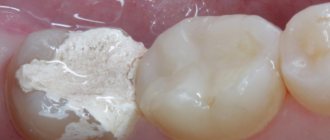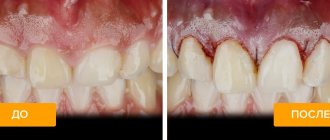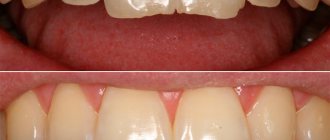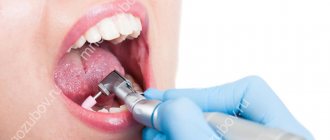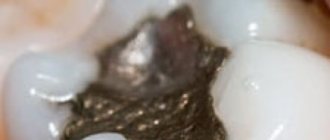In dental practice, there are often cases of advanced caries when a patient comes with complaints of acute toothache. If a doctor diagnoses pulpitis, then one of the stages of its treatment will be the installation of a temporary filling. It protects the canal from food and bacteria entering it. It should cover the exposed area of the tooth until treatment is completed by filling the canals and installing a permanent filling. In addition, the “temporary solution” is also relevant for a number of other pathologies.
Normally, the temporary “protection” is removed by the dentist. But there are situations when it falls out on its own. Why? Various factors can provoke this. But no matter what causes the temporary filling to fall out, it is important to know what to do in this situation and how to prevent complications from developing. After all, the consequences can be very unpleasant - from the spread of infection to the loss of a unit.
When is a temporary filling needed?
When a patient with caries comes to the dentist complaining of tooth pain, it is important for the doctor to assess how deeply the unit is affected and whether the roots and canals are affected. To do this, he sets up a “temporary station” for 2-3 days. If the nerve endings are damaged and a permanent filling is placed, the patient will again experience toothache and will have to have the tooth re-treated. A temporary filling will avoid unnecessary costs and stress.
The dentist decides to install temporary filling material if he diagnoses the patient with:
- deep caries;
- pulpitis;
- periodontitis;
- granuloma;
- tooth cyst;
- abscess.
Such dental manipulation is relevant if it is impossible to treat a tooth in one visit or you need to first relieve the inflammatory process. The doctor also places such a filling while the stump inlays or prostheses are being made in the laboratory.
What problems might there be?
Caries often occurs in the marginal area of tooth enamel. The vulnerability is due to the following reasons:
- A small gap forms between the dental tissue and the filling, where infections can enter.
- When preparation is carried out, a fragment of enamel is destroyed, microscopic cracks appear, and the enamel may break off.
The filling technology must be followed correctly. Saucer-shaped cavities will not hold materials as well. The dentist needs to ensure that the cavity is kept clean before filling to prevent infection.
The dentist who performed the installation will help you solve the problem of the temporary filling falling out. If a patient has doubts about his level of qualifications, he will have to look for a new doctor. The dental clinic must be licensed. Only in such institutions can you get a guarantee for your new teeth.
How long is it temporary?
The period for installing such a filling depends on the purpose and clinical situation. It can range from 3 days to several months. If the doctor uses arsenic-based paste, then further treatment is carried out after 3-5 days, a maximum of a week. You cannot walk with arsenic in your tooth for any longer, as it can not only kill the nerve, but also destroy healthy tissue.
If the material used is necessary to protect against food and bacteria getting inside the canals during their sanitation or treatment of inflammation, it can remain in the tooth for several weeks. For longer treatments, the dentist may replace temporary fillings if a new dose of medication becomes necessary.
Can arsenic harm the body?
If a nerve is inflamed, only a doctor can help. Treatment of pulpitis may include healing procedures or removal of pathological tissue. The choice depends on the stage of the lesion. If you contact the dentist right away, you can stop the inflammation process while preserving the nerve. The essence of surgical technologies is partial or complete removal of the pathological pulp.
Many patients are frightened by the loss of glue placed in the cavity of the unit for a certain period. It happens that patients accidentally swallow it. This will not lead to perforation of internal systems and organs, and the inflammatory process will not start from this. Arsenic is almost never used in the practice of modern dentists. Today, dentists are increasingly using special pastes that contain a small amount of the chemical element. The substance works as a necrotizing mixture. Such a dose is not capable of leading to poisoning.
If ingestion cannot be avoided, contact your dentist. Before seeing a doctor, call him and describe the situation to him. The doctor will tell you what actions you should take, because he is familiar with the problem. An unscheduled visit may be scheduled for re-filling. If there is no danger, the visit may take place on the previously planned day.
What causes a temporary filling to fall out?
A patient may have a temporary filling fall out due to medical negligence:
- if the doctor did not properly dry the tooth cavity after pre-treatment or saliva got there before applying the filling material;
- if, after cleaning the carious cavity, particles of infected tissue remain;
- if the surface is not processed well enough, which will cause the enamel to destroy the material;
- if the filling is placed on a pulpless tooth, in this case it cannot hold tightly, because the surface of the unit is fragile, nutrients do not reach it;
- if low-quality or expired materials were used to create a temporary filling;
- if the tooth is severely affected by caries and the filling does not have the necessary support.
But not only the doctor can be the culprit of the problem. A temporary filling falls out when the patient does not adhere to the recommendations received after dental procedures. For example, he decides to have a snack immediately after leaving the doctor's office. Despite the fact that you need to refrain from eating for 1-2 hours. In addition, the filling may fall out if there is a large load on it (when chewing nuts and candies, opening bottles with teeth, biting thread, etc.). Its gradual loosening is provoked by chewing gum and toffee candies, toffees.
Why do fillings fall out?
The main reason is poor material used to fill the canal or insufficient qualifications of the dentist who performed the treatment.
Why do teeth break off along with the filling:
- Wrong choice of materials. Using cheap cement. The filling falls off, and bacteria penetrate into the microcracks, causing the development of pulpitis, caries, and periodontal disease.
- Illiterate canal filling. If installed incorrectly, cracks appear and microbes and food penetrate inside the tooth, which leads to caries.
- The molars were processed poorly. If a tooth breaks off along with a filling, this may indicate improper cleaning of the surface from carious formations.
- Incorrectly performed preparatory stage, treatment. The molar cavity is not sufficiently dry and is treated with a solution.
- Thin dentin and enamel due to lack of calcium.
- End of service life of filling material.
- Solid food, candy, seeds, the habit of chewing a pencil, pen. Constant mechanical impact negatively affects the condition of molars.
Attention! If a filling breaks, this may indicate poor oral hygiene. Deposits and plaque formed in the absence of brushing the teeth contribute to the accumulation of pathogenic bacteria and lead to the development of caries.
How can you tell if a filling is about to fall out?
After filling, the material occupies the entire drilled cavity; there are no gaps between it and the tooth tissues. When gaps appear between the filling and the tooth, it wobbles when pressed with the tongue, and you need to consult a doctor to prevent the material from falling out.
If this has already happened, and the patient notices a hole in the problem tooth, you need to act consciously. You cannot seal it with chewing gum or insert cotton wool or other improvised materials into the cavity. It will not be possible to seal the hole hermetically; such measures can only do harm, because this will create favorable conditions for the proliferation of pathogenic microorganisms and the spread of infection.
Causes of cracked teeth
The force of pressure on the teeth when chewing reaches 400 kg/cm². Healthy and strong crowns can easily cope with such a load. If the enamel is weakened or excessive pressure is applied, the tooth can crack. Factors contributing to the appearance of cracks in teeth:
- malocclusion, bruxism;
- depulpation (removal of a nerve);
- absence of one/several teeth (uneven load distribution);
- deep caries (destruction of 50% of the crown or more);
- injuries (fall, blow to the face, accident);
- genetically determined weakness of tooth enamel;
- poor nutrition leading to a lack of fluoride, calcium, phosphorus;
- excess sugar in the diet;
- temperature changes when eating (cold-hot);
- habit of biting pens and nails;
- teeth whitening at home;
- traumatic treatment of dental canals, excessive tightening of braces.
Important! Teeth with weakened enamel may crack when eating hard foods (such as crackers). However, chipped teeth more often occur due to prolonged exposure to adverse factors.
What to do?
Of course, you need to see a dentist. But the patient does not always have the opportunity to urgently leave work. In addition, many people believe that there is nothing wrong with a filling falling out and are in no hurry to visit the dentist.
When the doctor places a filling, he notifies the patient about what materials are used and for how long it is installed. It is important to remember this, because if the doctor used arsenic-based paste to kill the nerves, then one should not hesitate in case of material loss. This substance is poisonous! If it gets on the mucous membrane, it causes a burn, and if swallowed, it causes poisoning, gastrointestinal upset, and the development of an allergic reaction.
Therefore, if the patient notices a hole in the tooth, he needs to thoroughly rinse the oral cavity with a soda solution (dissolve 1 teaspoon of soda in 1 glass of warm boiled water and add a few drops of iodine). After this, you need to cover the hole with a sterile gauze swab and go to the doctor.
If the dentist filled the canals and installed a temporary filling, but it fell out, this is not so dangerous. After all, there is no toxic substance inside the tooth and infection will no longer penetrate into the canals. But you still need to visit a dentist to solve the problem. The doctor will conduct an examination and decide what to do - put a temporary filling again or replace it with a permanent one.
We recommend remembering the following algorithm of actions:
- If the filling falls out while eating, it is better to spit out the chewed food. After this, you need to rinse your mouth with an antiseptic (Chlorhexidine, Miramistin) or a soda solution. If you don't have this on hand, you can use mouthwash or clean water.
- You should not try to close the hole with chewing gum or other improvised means, or pick out the remnants of the filling material. There is a risk of damaging the mucous membrane or leaving a piece of the used “tool” in the hole, which will provoke the development of the inflammatory process. Do not try to insert a painkiller or antibiotic tablet into the hole. It won't help.
- Before eating, it is necessary to cover the damaged unit with a sterile gauze pad and minimize the load on this side of the jaw. Be sure to rinse your mouth thoroughly after every meal.
- If pain bothers you, you can take a non-steroidal anti-inflammatory drug, for example, Nurofen, Trialgin, Ketanov, etc. The recommended duration of taking these medications without medical supervision is no more than 3 days.
- As a result, in any case, you need to make an appointment with the dentist and have your tooth treated.
It should be remembered that you should not put off visiting a doctor until later. This is fraught with the development of an inflammatory process and may lead to the need to remove the unit.
Tip #4: Take pain medication
Immediately after installing a temporary filling, many patients complain of pain. Most often, the pain in the first hours and days is associated with the preparation of tissues and the fact that the medicine put inside has not yet fully worked, has not coped with the inflammatory process, and has not killed the pulp (if a devitalizing composition has been used). But if the material falls out, the pain usually intensifies. To eliminate it, take an analgesic from your home medicine cabinet, such as Nurofen or Ketanov.
Take a painkiller to relieve pain
Under no circumstances place an Aspirin or Analgin tablet into the tooth cavity, as some Internet sources advise! You can cause irritation, swelling and burns of the tissue, which will lead to an even more severe pain reaction.
To reduce pain, you can also use decoctions of chamomile and sage, a solution of soda and salt.
Filling falling out during pregnancy
If a temporary filling falls out in a pregnant woman, it is also important to consult a specialist. If at the time of treatment she is in her third trimester, and a complex dental procedure is ahead, the doctor can install a new “temporary” and transfer the therapy to the postpartum period.
It is worth remembering that pregnancy is not a contraindication for visiting the dentist. On the contrary, it is better to visit this doctor more often to prevent the progression of caries. After all, this is a collection of microbes that can spread throughout the body and cause harm to health.
Tip #2: Don’t rely on recommendations from online forums
A temporary filling has fallen out and you don’t know what to do in this situation? First of all, give up the idea of taking advantage of the dangerous recommendations of some Internet users. Under no circumstances should you do the following:
- cover the resulting cavity with chewing gum: you can introduce infection inside,
- pick out the remains of the filling and the medicine inside with a needle or other sharp objects: there is a high probability of damage to the soft tissues of the oral cavity. During the manipulation, there is a risk of breaking the needle, and it will be impossible to pull out the fragment on your own, which will lead to the development of inflammation. The use of sharp objects is fraught with the exact opposite effect - you will drive deeper the remains of the medicine and bacteria from the external environment,
- put antibiotics or tablets inside yourself: this can increase the pain and worsen the condition of the pulp, dentin and surrounding tissues.
Don't pick your teeth yourself
Prevention of temporary filling falling out
After the performed manipulations, the doctor always tells the patient what can and cannot be done after he leaves the office. And you need to follow these recommendations.
- You should not eat for 2 hours after filling. At this time, the material hardens.
- During the entire period while the temporary filling is in place, you must not chew nuts and other hard foods, eat chewing candies and other sticky sweets, or use chewing gum.
- It is recommended to minimize the load on the problematic tooth.
- Do not use a waterpik, toothpicks or dental floss to clean a temporary filling. The optimal hygiene product is a soft brush.
It is recommended to inspect the filling daily so that if defects appear, you can detect them in a timely manner and contact your dentist.
How long can you walk without a filling and what to do if it falls out?
You need to make an appointment with a doctor as soon as possible. This is especially true if the tooth hurts after the filling has fallen out. If you still cannot visit the office, you should follow a number of simple rules before doing so. This will help minimize harm and avoid complications.
- Do not put pressure on the tooth or chew hard foods on it.
- It is better not to chew on a damaged tooth at all.
- The oral cavity can be rinsed with chamomile decoction, soda and saline solutions at a comfortable temperature.
- Be extremely careful when brushing your teeth, do not put a toothpick or other sharp objects into the hole.
During the examination, the dentist will determine the cause of the problem and will be able to eliminate the problem as quickly as possible.
Possible complications
When a temporary filling falls out, not all patients immediately consult a doctor. Some people don’t rush to the doctor until the tooth starts to hurt. And in vain, since the consequences can be extremely negative:
- spread of the inflammatory process due to the penetration of pathogenic microorganisms, which will require longer treatment;
- chipping of the crown, which will lead to the need for additional strengthening of the tooth;
- injury to the mucous membrane of the cheeks and tongue and, as a result, pain;
- the need to remove the unit.
How long does it take to walk with a hole? It's up to the patient to decide. But any dentist will tell you that you need to come for an appointment as soon as possible.
| Author of the article: | Gasparyan Eliza Arturovna |
| Speciality: | Dentist-therapist, dentist-endodontist |
| Experience: | 10 years |
Make an appointment
Comments
The doctor recently put in a temporary filling, told me to come back only in a week, but the tooth underneath it hurts very much, I can’t stand it, I’m very, very nervous... Is it possible to somehow pull it out ahead of time?
Kira (03/02/2020 at 00:55) Reply to comment
- Dear Kira, pain after installing a temporary filling can indicate both a pathological process and be a normal tissue reaction to the intervention. In both cases, you cannot try to remove the filling yourself, but it is not forbidden to visit a doctor unscheduled - the specialist will determine the true cause of the pain, and you will stop being nervous.
Editorial staff of the portal UltraSmile.ru (03/11/2020 at 09:04) Reply to comment
If you followed all the recommendations of your dentist, but the temporary filling still fell out, then this is a reason to think about changing your dentist. I think so. Where is the guarantee that he will then install the permanent one poorly?
Pavel (03/20/2020 at 10:07 am) Reply to comment
Good afternoon I once had a tooth crumble and its treatment took several days. They gave me a temporary filling and told me not to eat for several hours so that everything would harden. The remains of the tooth did not hurt under the temporary filling, since my nerve was removed, but if they put a temporary filling on the tooth where caries was treated, how to avoid pain?
Dmitry Ch. (03/20/2020 at 11:29 am) Reply to comment
At the appointment, the doctor began treatment and placed a temporary filling. The next visit was scheduled in five days. But the tooth began to bother me in the evening after visiting the doctor. Tell me if you need to see a doctor earlier than the appointed day
Svetlana (03/20/2020 at 11:56 am) Reply to comment
Tell me, if the temporary filling fell out over the weekend and my doctor doesn’t have an appointment for the next few days, will I have to walk around with cotton wool in my tooth? Maybe there is some special remedy for the time being?
Maria K (03/20/2020 at 12:12 pm) Reply to comment
My son is 10 years old. They put a temporary filling with medicine, the doctor told me to come back in 10 days. 5 days have passed, the tooth hurts. What should we do when we go to remove the tooth?
Tatyana (03/20/2020 at 01:03 pm) Reply to comment
Hello. I would like to know the opinion of a professional, because different doctors answer my question differently. Back in the days of the Soviet Union, I was given a filling. It does not have a very aesthetic appearance, it is dark in color and those who are not in the know always point out to me that the tooth needs to be treated. Do you think it’s worth changing it if the tooth itself doesn’t bother you and the filling is done, as they say, to last forever. Or is there some modern way to simply cover up the color of the filling? Best regards, Asya.
Asya (03/20/2020 at 14:01) Reply to comment
This is terrible, I swallowed a temporary filling, what will happen now?
Tatyana (03/22/2020 at 06:14 pm) Reply to comment
- Modern filling materials are safe and, if swallowed, do not cause serious consequences for the body. But the medications that are under them can provoke irritation and upset of the gastrointestinal tract, and an allergic reaction. But in any case, there is no need to be nervous, because the dose of medications is small, they cannot cause serious harm to an adult body. To neutralize the negative effects of medications, you can take Polysorb and an antihistamine (for example, Zodak). Also be sure to contact your dentist to have the filling reinstalled or a permanent restoration done if necessary.
Editorial staff of the portal UltraSmile.ru (03/27/2020 at 09:27) Reply to comment
Good afternoon Please tell me, four days ago I got a temporary filling. At first everything was fine, but a couple of days ago my tooth started to hurt horribly. I called the clinic and they told me that there was nothing wrong with it and that you would come for an appointment in 6 days. I wanted to know if this is normal or is it better to go to another doctor? Because I don’t understand anything at all about dentistry.
Yana (04/23/2020 at 07:42) Reply to comment
Please specify what is the maximum service life of a temporary filling? My husband was given a temporary filling and an appointment was scheduled for only a month later. Now I’m worried whether wearing it for such a long time will have a negative impact, because about ten years ago my colleague delayed her visit to the dentist after installing a temporary filling, which led to tooth extraction.
Victoria (04/23/2020 at 07:53) Reply to comment
Why does a temporary filling still fall out, even if the patient was careful and followed the dentist’s advice? Maybe, among other things, there is some kind of rejection by the body of the materials that make up its composition?
Dmitry (04/23/2020 at 08:56) Reply to comment
Hello, what could be the reasons for a temporary filling falling out? Unprofessionalism of the doctor? Or something else more significant? Is it true that a temporary filling is harmful to the body?
Mikhail (04/23/2020 at 09:09) Reply to comment






